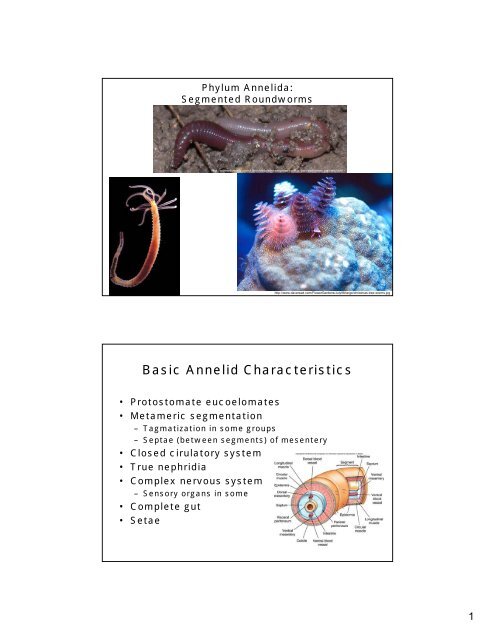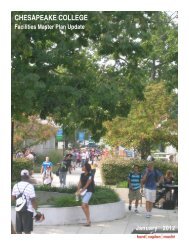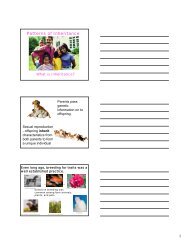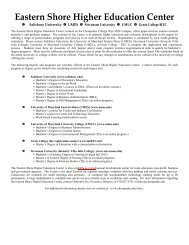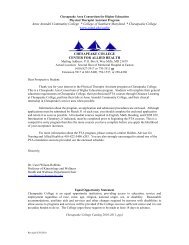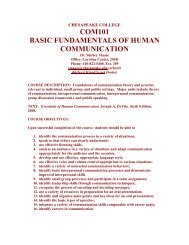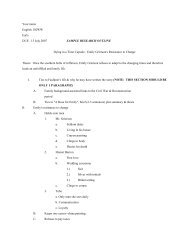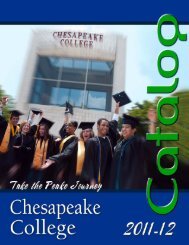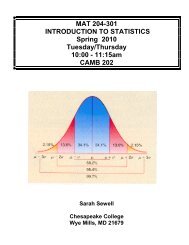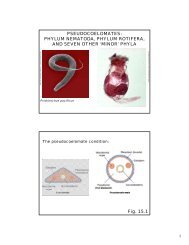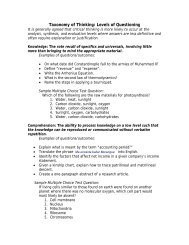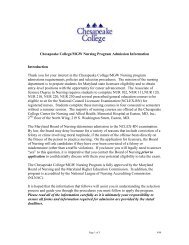Basic Annelid Characteristics
Basic Annelid Characteristics
Basic Annelid Characteristics
- No tags were found...
Create successful ePaper yourself
Turn your PDF publications into a flip-book with our unique Google optimized e-Paper software.
Phylum <strong>Annelid</strong>a:Segmented Roundwormshttp://animaldiversity.ummz.umich.edu/site/resources/cynthia_parr/earthworm.jpg/view.htmlhttp://www.daveread.com/FlowerGardens/July98/large/christmas-tree-worms.jpg<strong>Basic</strong> <strong>Annelid</strong> <strong>Characteristics</strong>• Protostomate eucoelomates• Metameric segmentation– Tagmatization in some groups– Septae (between segments) of mesentery• Closed cirulatory system• True nephridia• Complex nervous system– Sensory organs in some• Complete gut• Setae1
Three classes of annelids• Polychaeta (“many setae”): bristle worms– Mostly marine– Have parapodia– Have complex sensory organs (sight, chemosensation,mechanosensation (?) )2
Three classes of annelids• Polychaeta (“many setae”): bristle worms• Oligochaeta (“few setae”): earthwormsFig. 17.13
Fig. 17.12cNot all earthworms are smalland plain…http://www.dpi.vic.gov.au/CA25677D007DC87D/LUbyDesc/phearthworm/$File/phearthworm.jpghttp://maguires.com/research/images/giant_earthworm/g_earthworm_1.jpgwww.sfu.ca/~fankbone/v/lab08.html4
Three classes of annelids• Polychaeta (“many setae”): bristle worms• Oligochaeta (“few setae”): earthworms• Hirudinea: leechesFig. 17.225
It is now recognized that Oligochaeta and Hirudinea, comprised of several thousandspecies, form a clade and should be referred to either as Oligochaeta (Siddall et al.,2001) or Clitellata (Martin, 2001). Moreover, it is possible that this group may well belonginside Polychaeta, thus making Polychaeta synonymous with <strong>Annelid</strong>a (McHugh, 1997;Westheide, 1997; Westheide et al., 1999).The former phyla Pogonophora and Vestimentifera have also recently become regarded as asingle, clearly annelid, group (Bartolomaeus, 1995; Nielsen, 1995; Rouse and Fauchald, 1995),and are now known by the original name, Siboglinidae (see Rouse and Fauchald , 1997 andMcHugh 1997).http://tolweb.org/<strong>Annelid</strong>aRiftia pachyptila : hydrothermal vent wormshttp://www.mbari.org/staff/jones/images/riftia.jpgwww.unbsj.ca/sase/biology/huntlab/index.htm6
http://bugs.bio.usyd.edu.au/Polychaetes/riftia_and_hydrothermal_ve.htmThe Giant Worm Museum, advertised as "The Wonder From Down Under", "aworld first" and a place where you can "see the world's largest earthworms on display".This 100m structure, in the likeness of the worms it celebrates, allows thevisitor to crawl through a magnified worm burrow and walk through asimulated worm's stomach. It also features a theatrette, a natural historyof worms, a marine worm tank and a local history display.Gippsland is in fact the only region in the world which produces the giantworms, which can grow to nearly 3 metres in length.The attraction offers a unique opportunity of close contact & handling ofour popular wildlife. Amenities - 150 seat coffee shop - gift shop, BBQ &picnic areas, toilets, coach & car parking. Open every day 10am - 5pm.Bass Highway, Bass. Contact (03) 5678 2222www.langlang.net/nearby.html7
Phylum Onychophora: “velvet worms”Little morphological changein the last 500 million years.An uncommon and not verydiverse group (~70 spp).http://www.cals.ncsu.edu/course/zo150/mozley/fall/Onychophora.jpghttp://bioweb.uwlax.edu/zoolab/Table_of_Contents/Lab-6a/Phylum_Onychophora_2/phylum_onychophora_2.htmProtostomateChitin + protein cuticleAntennae (like Arthropoda)Unjointed legs (resemble parapodia)Open circulatory system (likeArthropoda)Paired nephridia (like <strong>Annelid</strong>a)Respiration via a tracheal system(like Arthropoda)8


